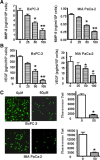FoxM1 is a novel target of a natural agent in pancreatic cancer
- PMID: 20354770
- PMCID: PMC2975383
- DOI: 10.1007/s11095-010-0106-x
FoxM1 is a novel target of a natural agent in pancreatic cancer
Abstract
Purpose: Pancreatic cancer remains the fourth most common cause of cancer-related death in the United States. Therefore, novel strategies for the prevention and/or treatment are urgently needed. Genistein has been found to be responsible for lowering the rate of pancreatic cancer. However, the molecular mechanisms by which genistein elicits its effects on pancreatic cancer cells has not been fully elucidated. Therefore, the purpose of the current study was to elucidate the anti-cancer mechanism(s) of genistein.
Methods: Multiple molecular techniques, such as Real-time RT-PCR, Western blot analysis, invasion assay, immunofluorescence assay, gene transfection, MTT assay, and Histone/DNA ELISA, were used.
Results: We found that genistein inhibited cell growth accompanied by induction of apoptosis with concomitant attenuation of FoxM1 and its downstream genes, such as survivin, cdc25a, MMP-9, and VEGF, resulting in the inhibition of pancreatic cancer cell invasion. We also found that down-regulation of FoxM1 by siRNA prior to genistein treatment resulted in enhanced cell growth inhibition and induction of apoptosis.
Conclusion: This is the first report showing the molecular role of FoxM1 in mediating the biological effects of genistein in pancreatic cancer cells, suggesting that FoxM1 could be a novel target for the treatment of pancreatic cancer.
Figures






References
-
- Jemal A, Siegel R, Ward E, Hao Y, Xu J, Thun MJ. Cancer statistics, 2009. CA Cancer J Clin. 2009;59:225–49. - PubMed
-
- Sarkar FH, Li Y. Mechanisms of cancer chemoprevention by soy isoflavone genistein. Cancer Metastasis Rev. 2002;21:265–80. - PubMed
-
- Sarkar FH, Li Y. The role of isoflavones in cancer chemoprevention. Front Biosci. 2004;9:2714–24. - PubMed
-
- Sarkar FH, Li Y. Soy isoflavones and cancer prevention. Cancer Invest. 2003;21:744–57. - PubMed
-
- Sarkar FH, Li Y. Using chemopreventive agents to enhance the efficacy of cancer therapy. Cancer Res. 2006;66:3347–50. - PubMed
Publication types
MeSH terms
Substances
Grants and funding
LinkOut - more resources
Full Text Sources
Other Literature Sources
Medical
Miscellaneous

